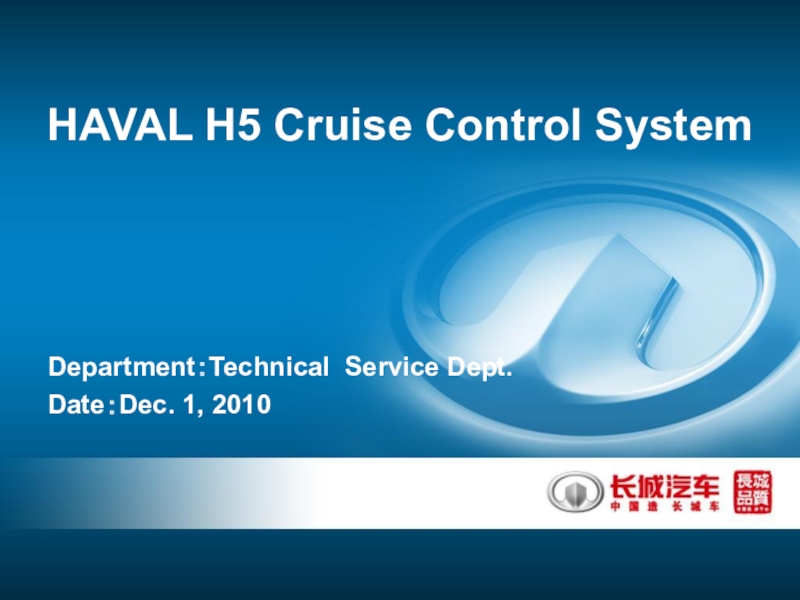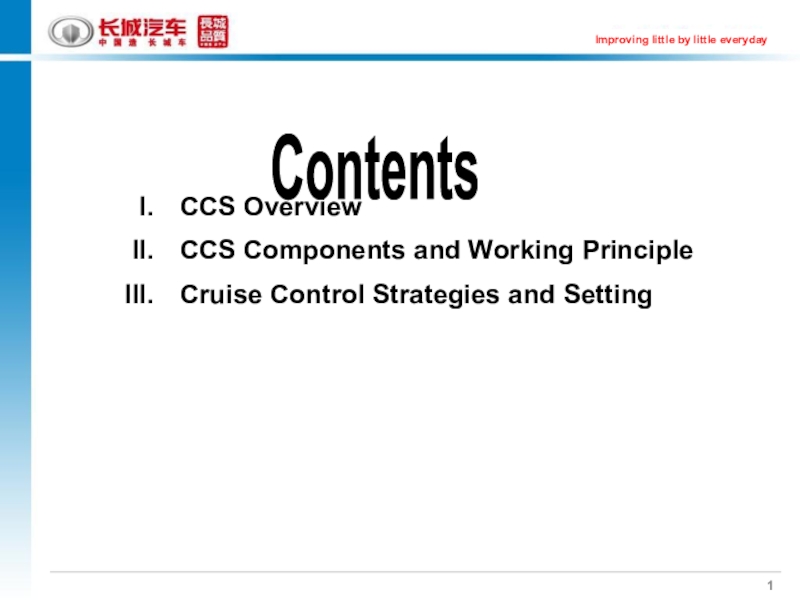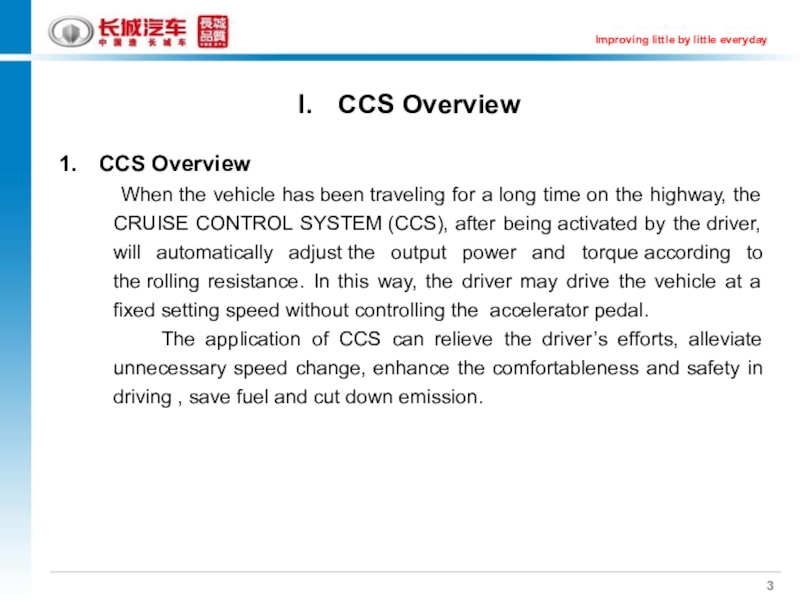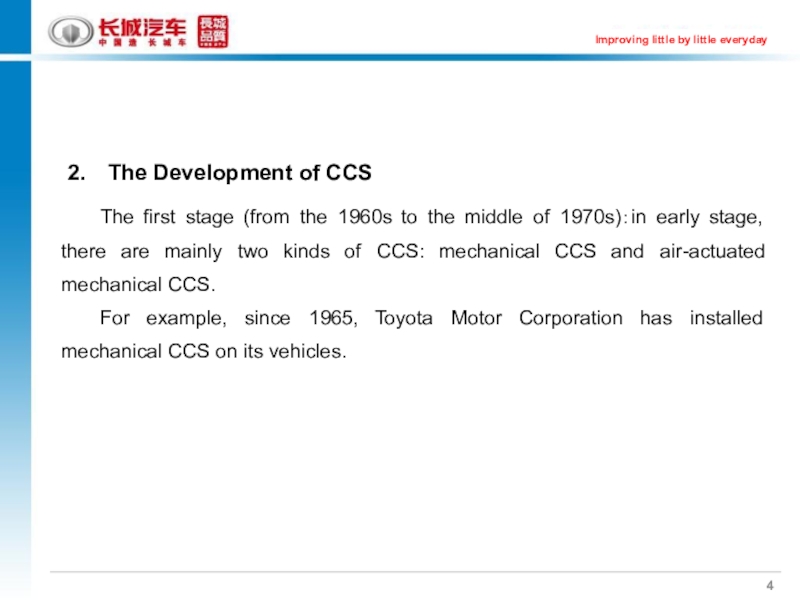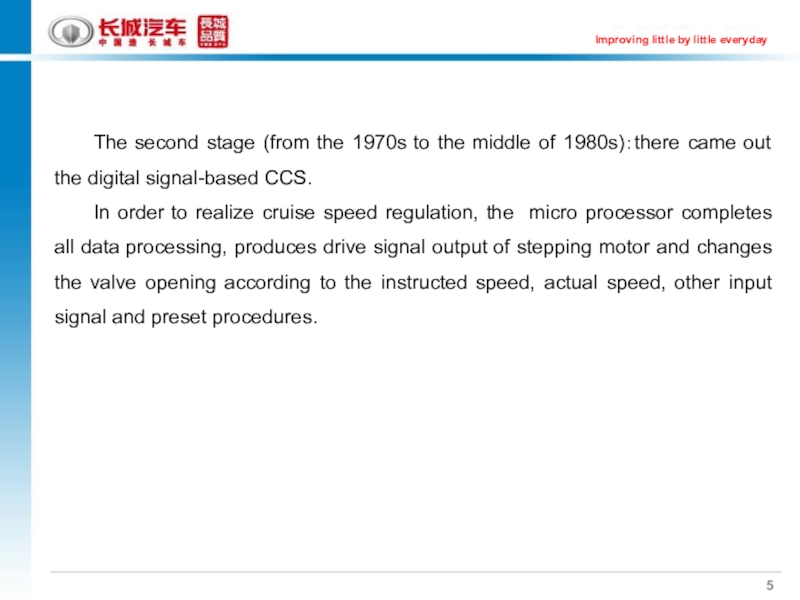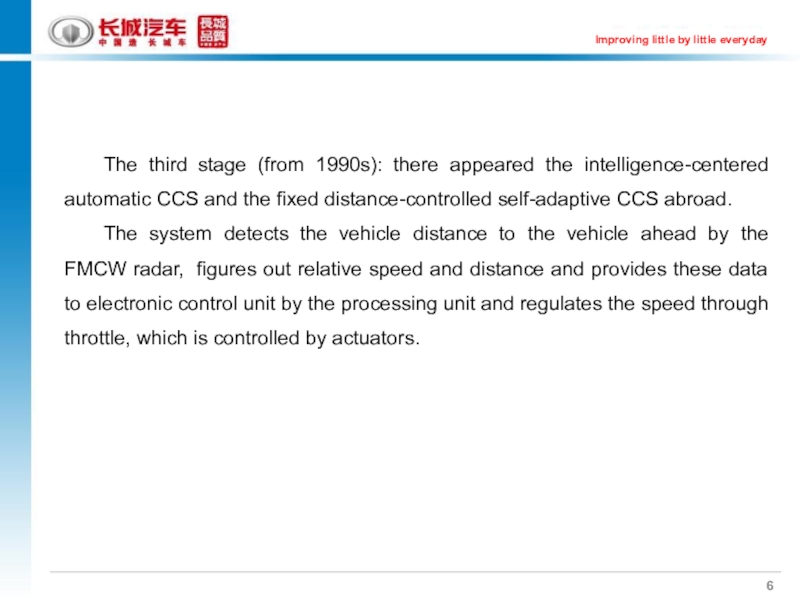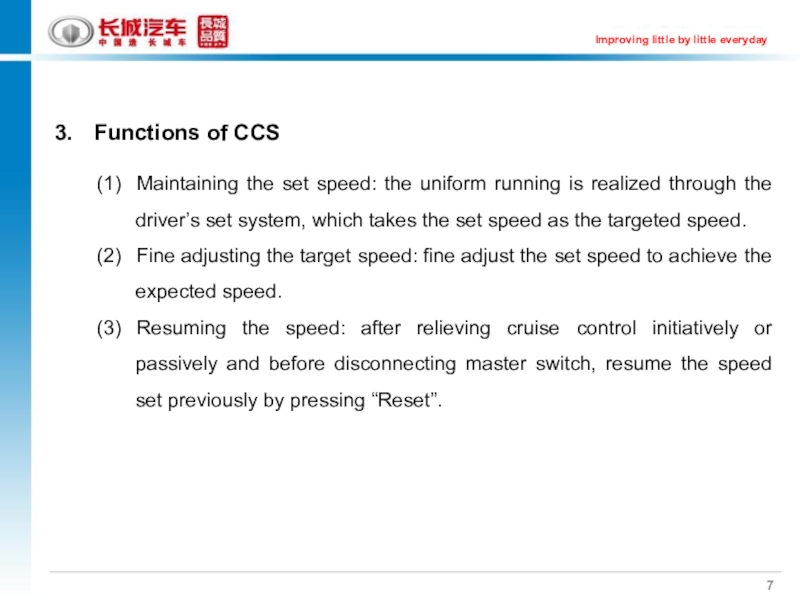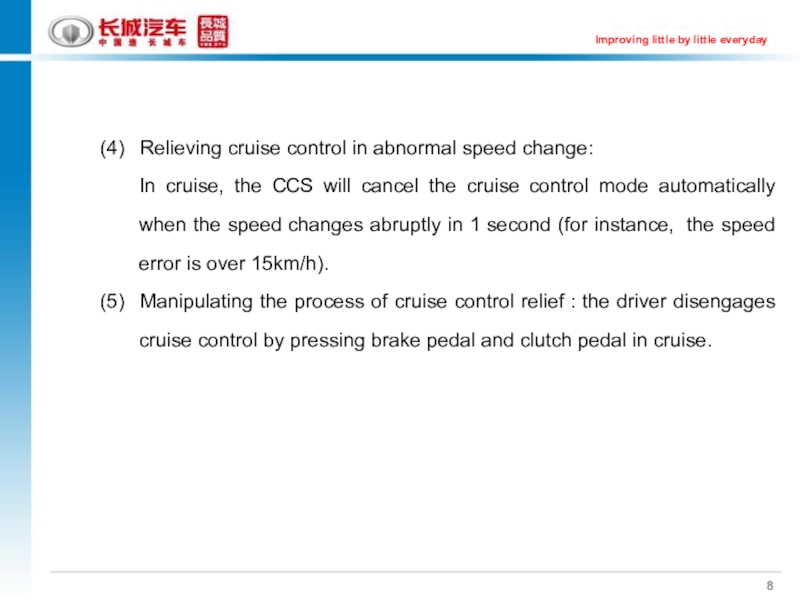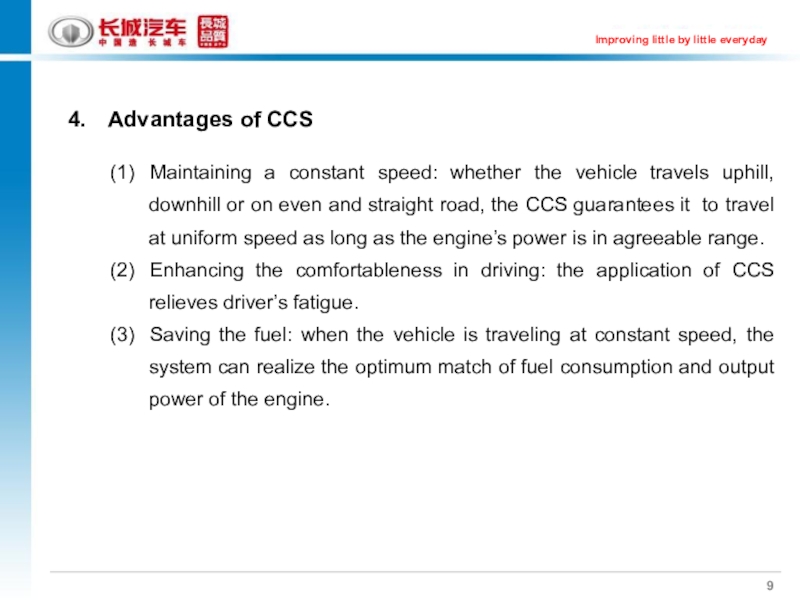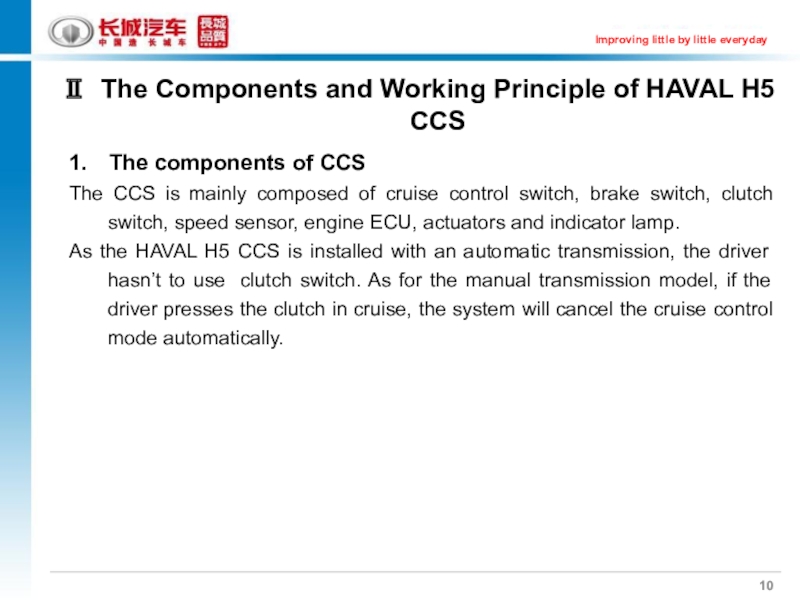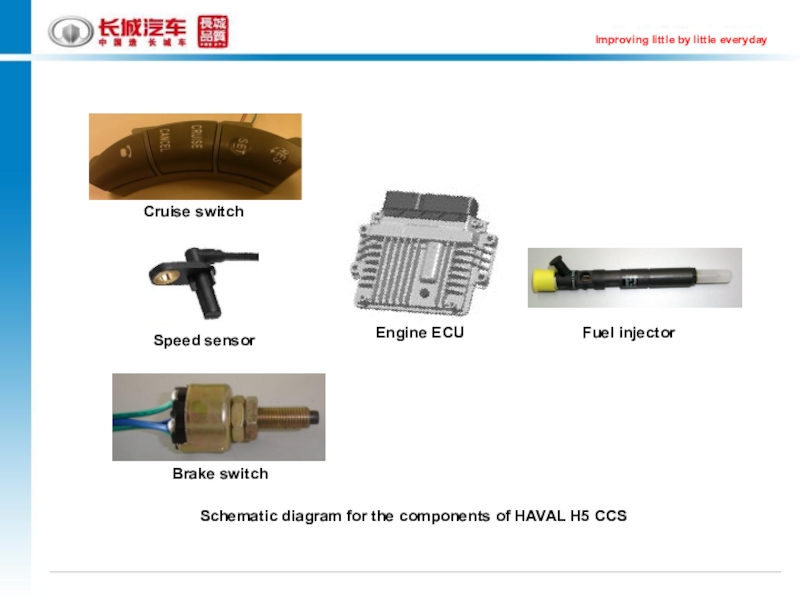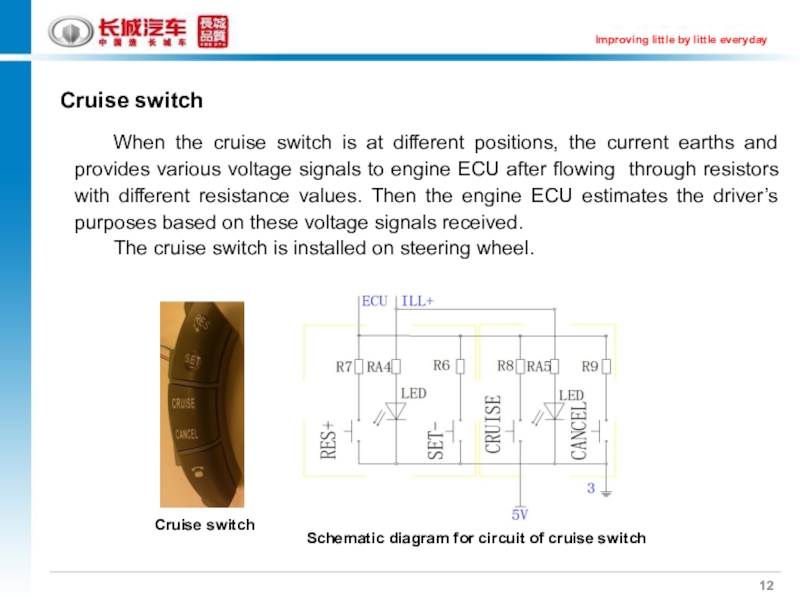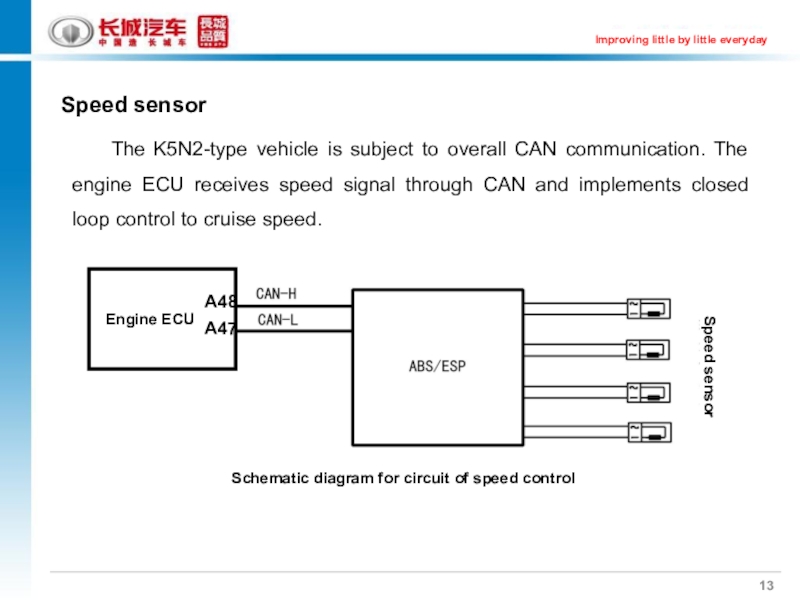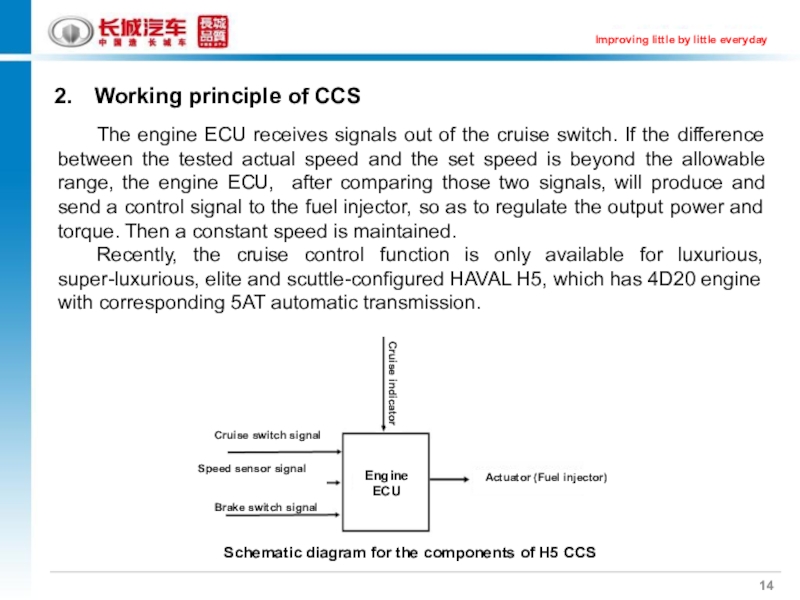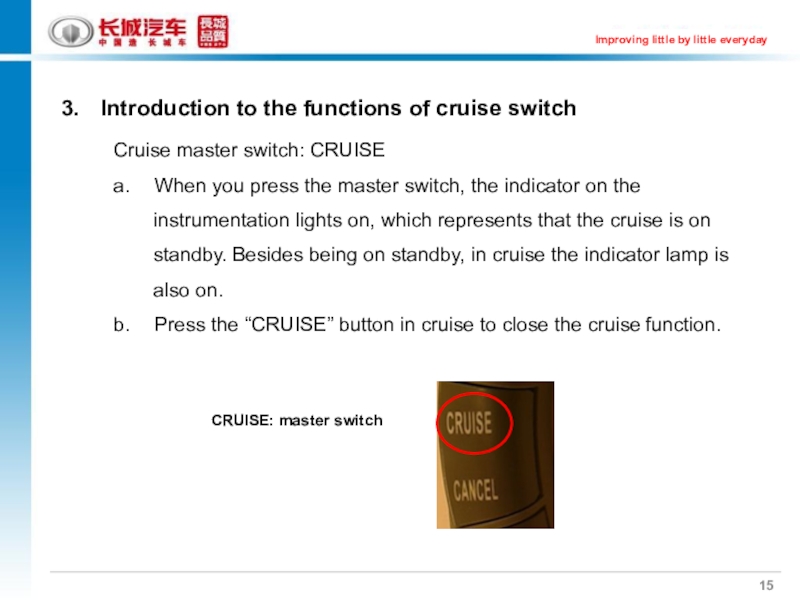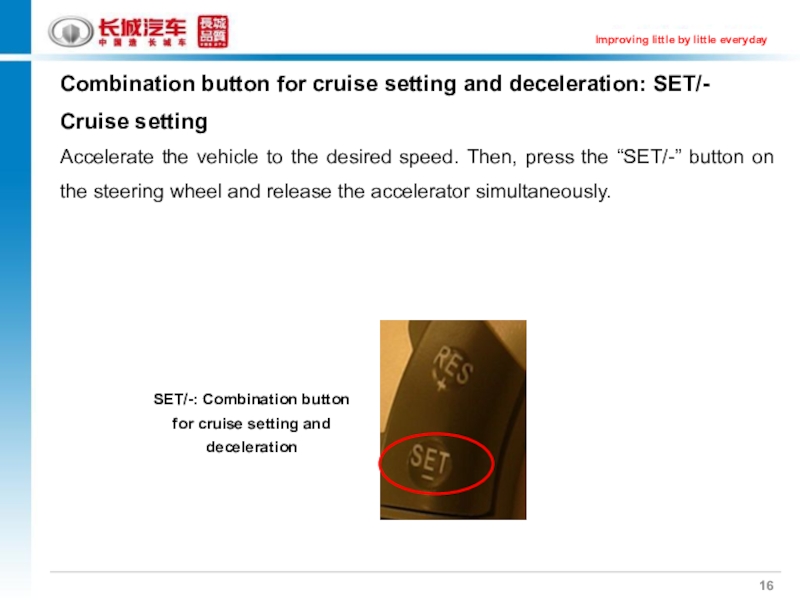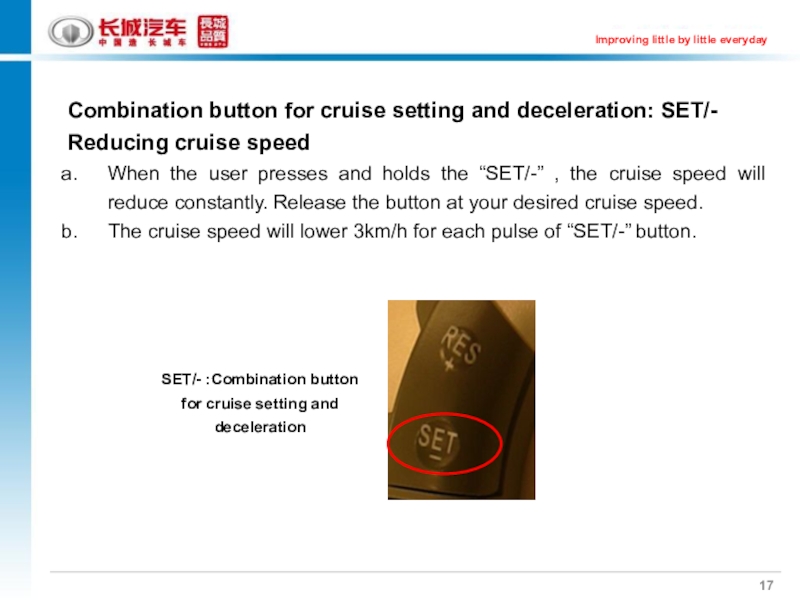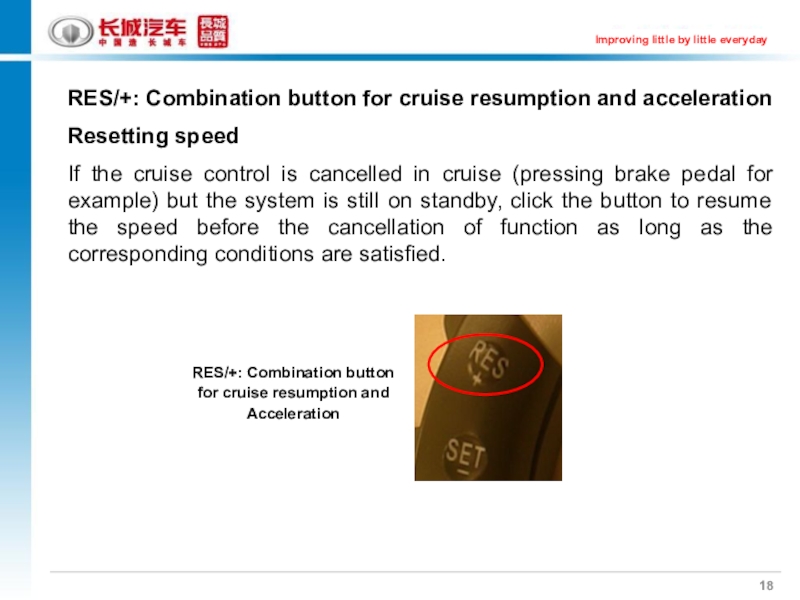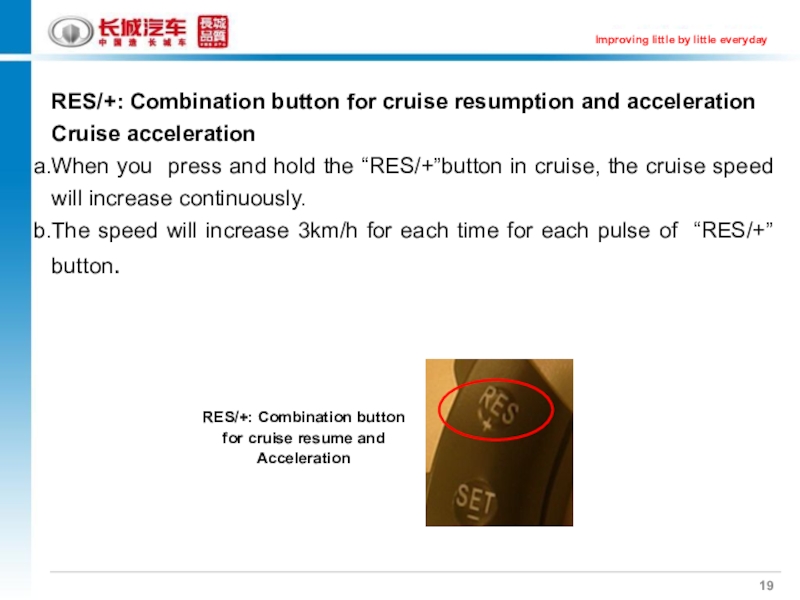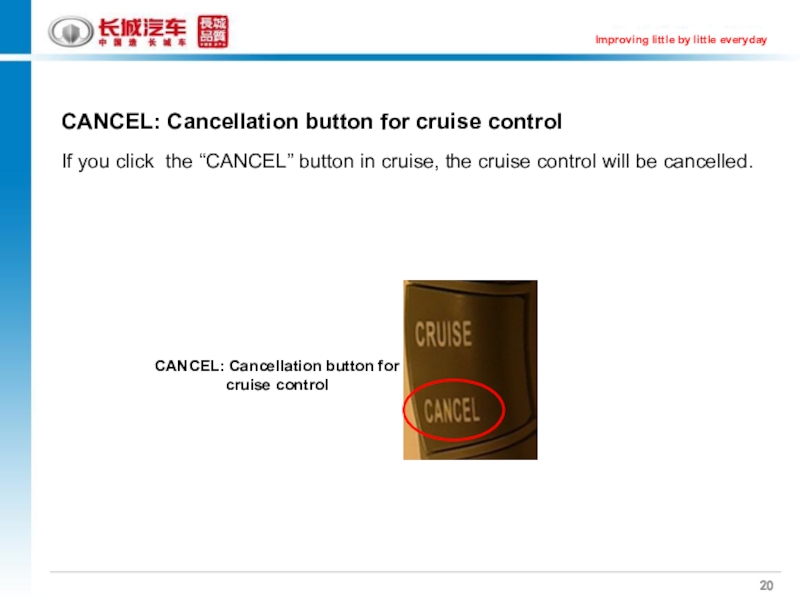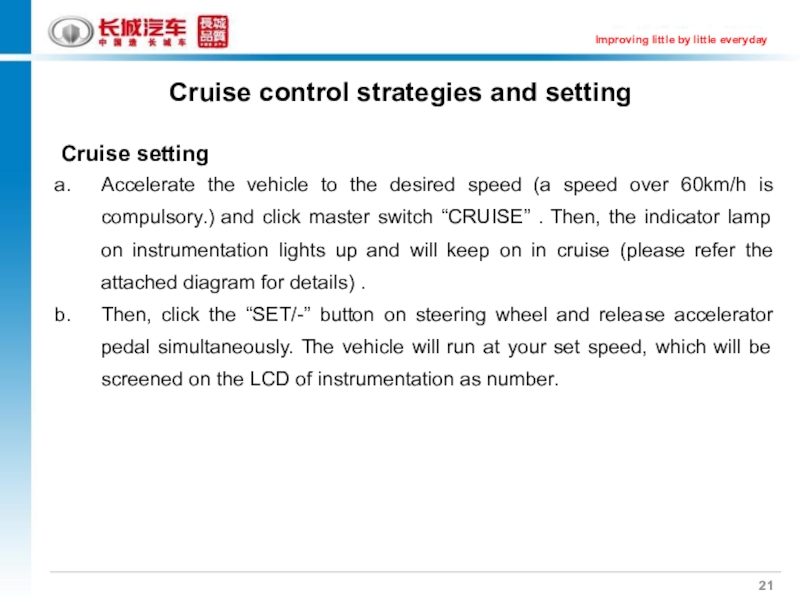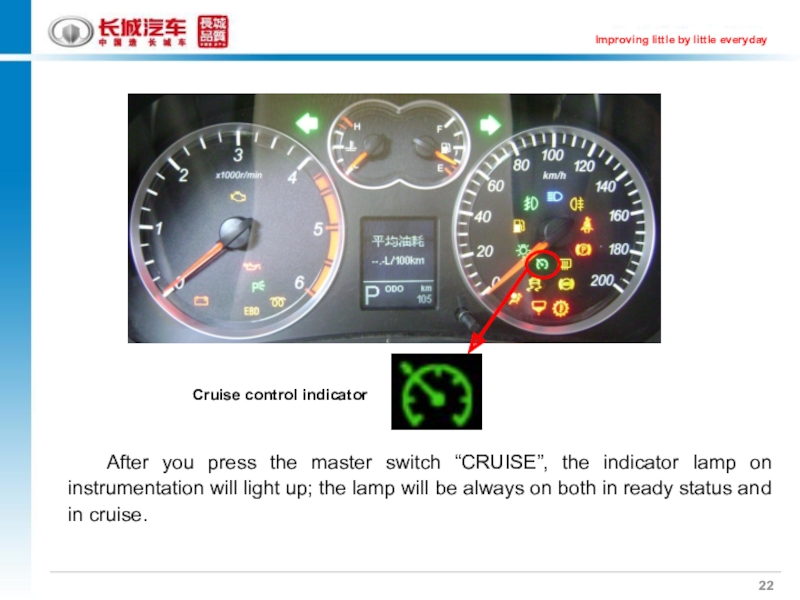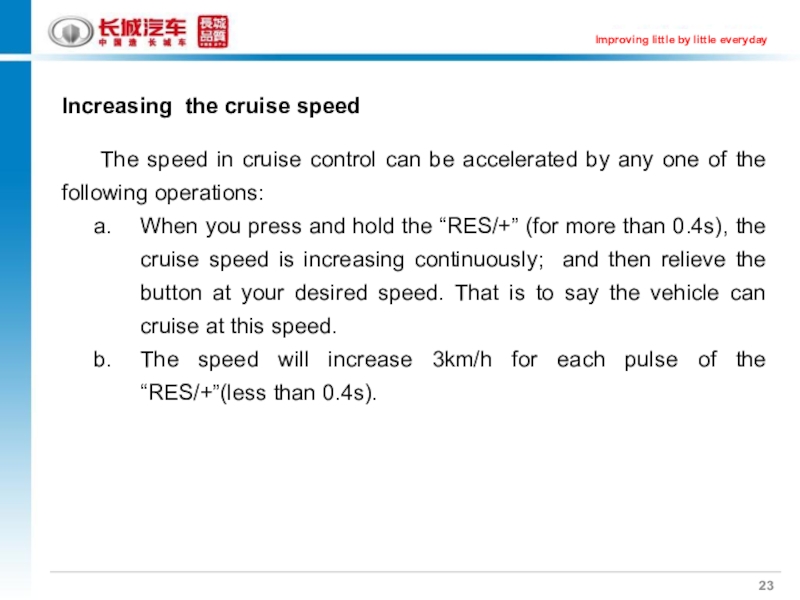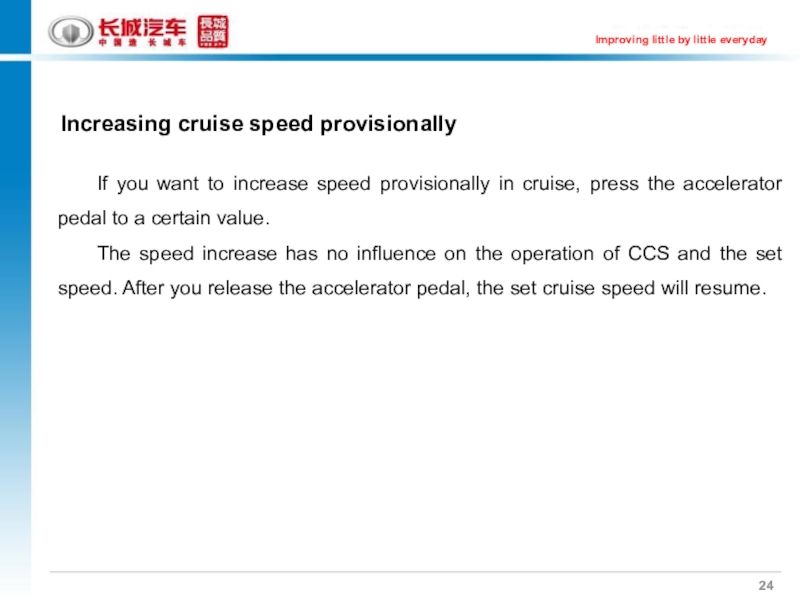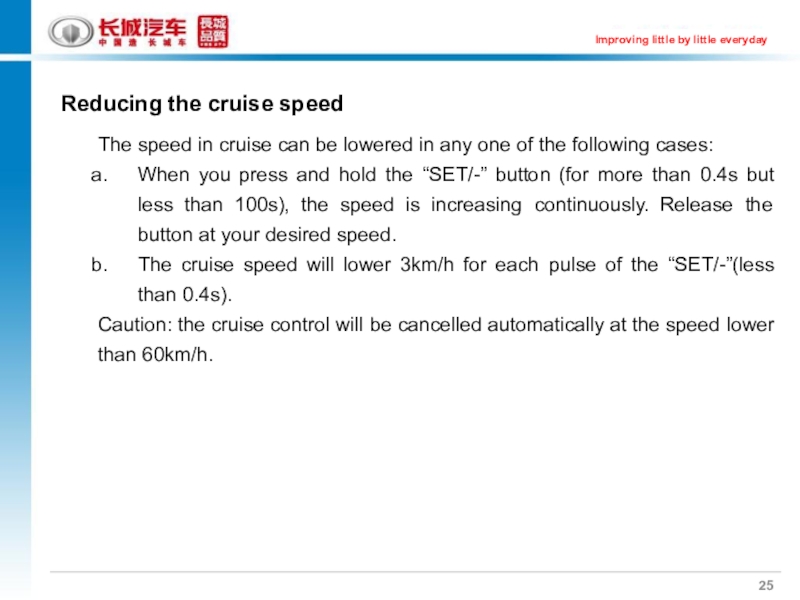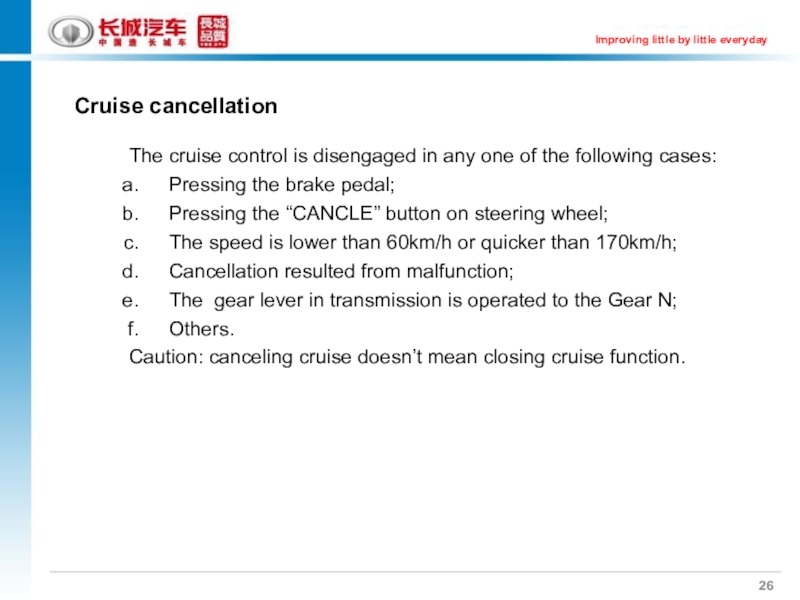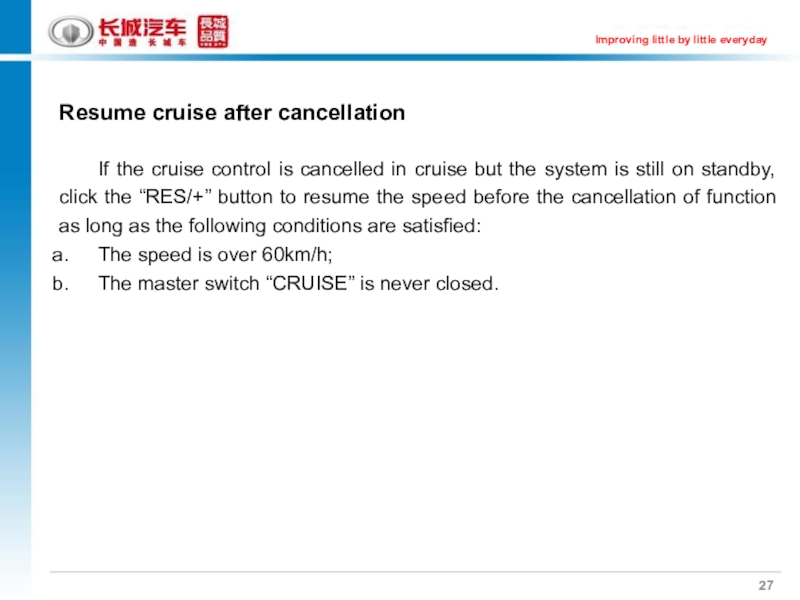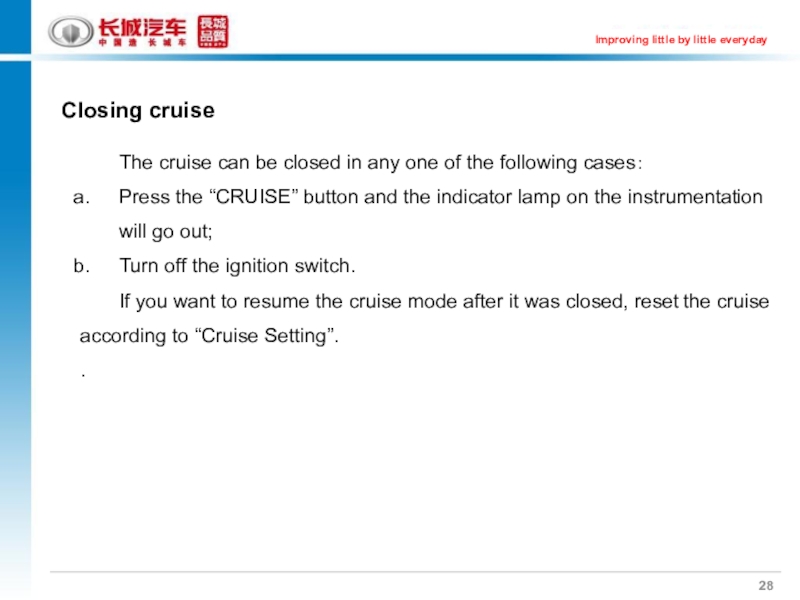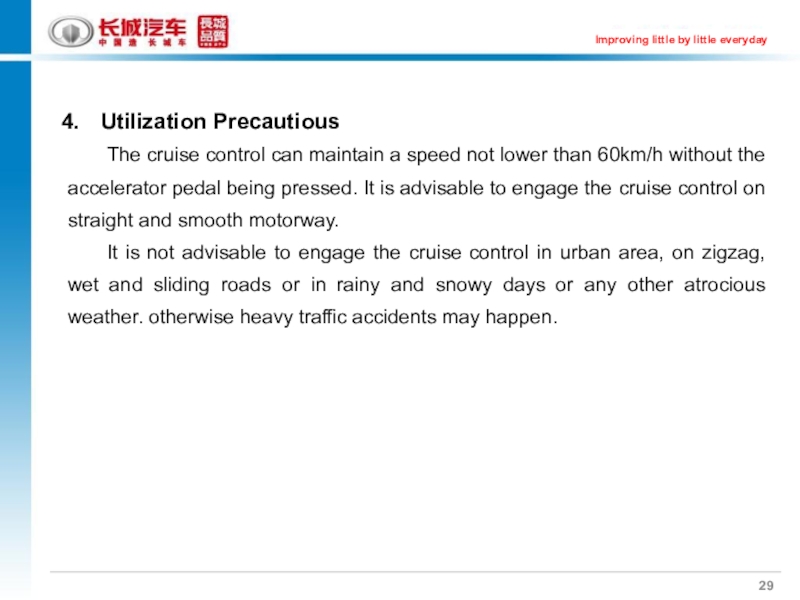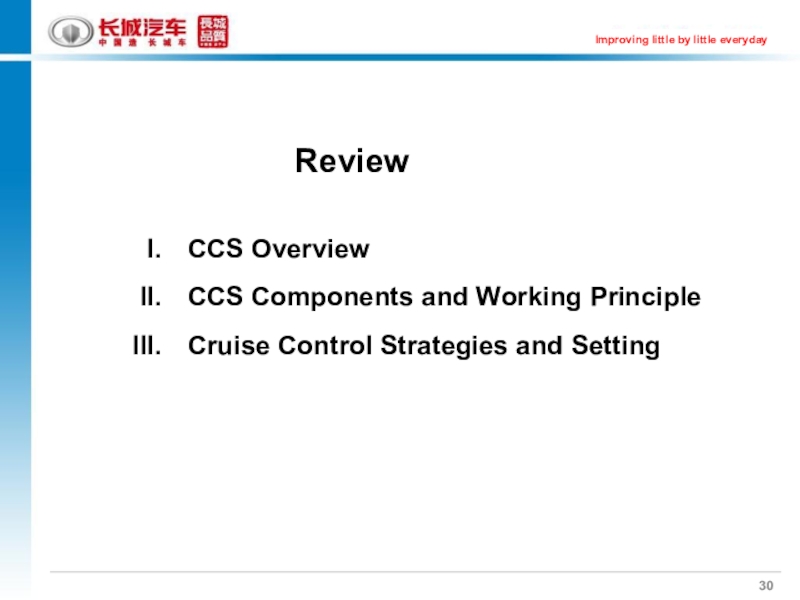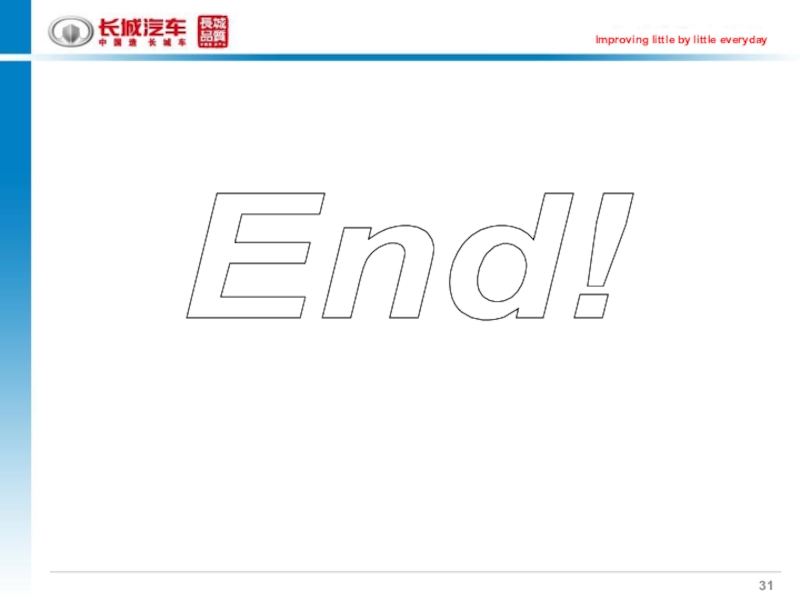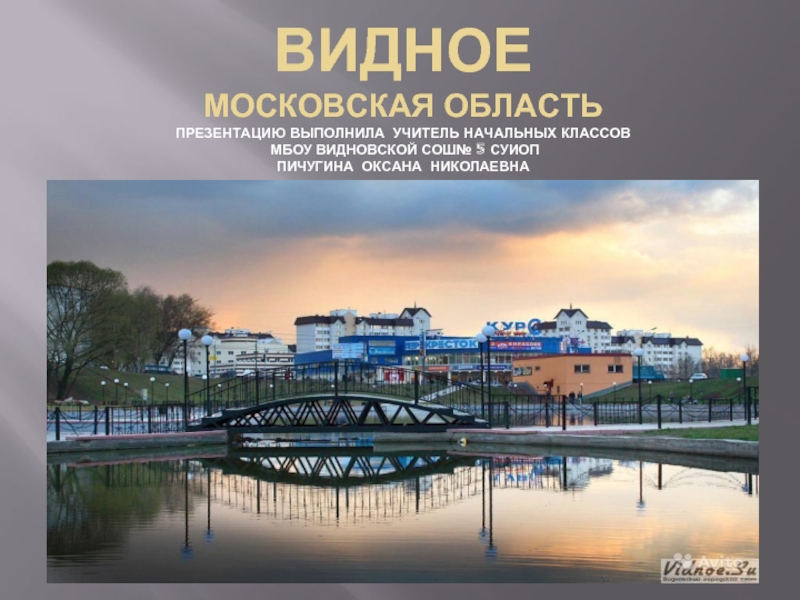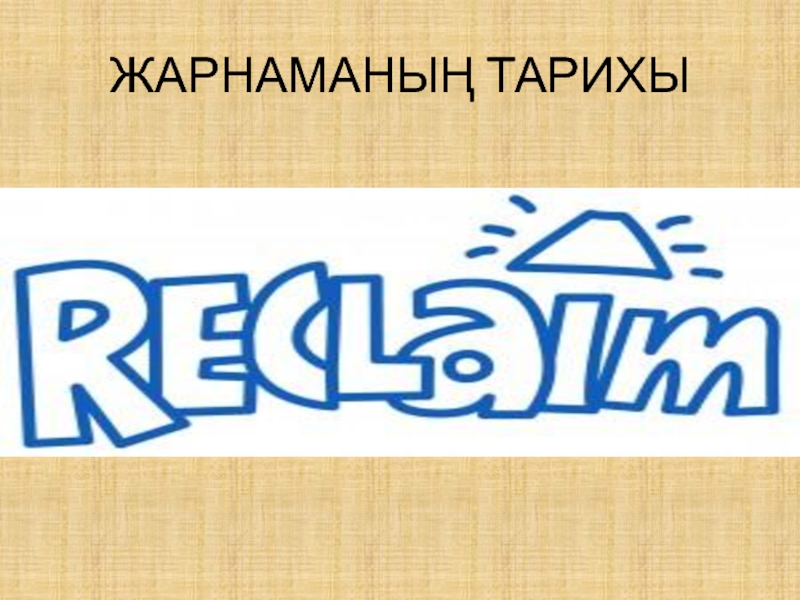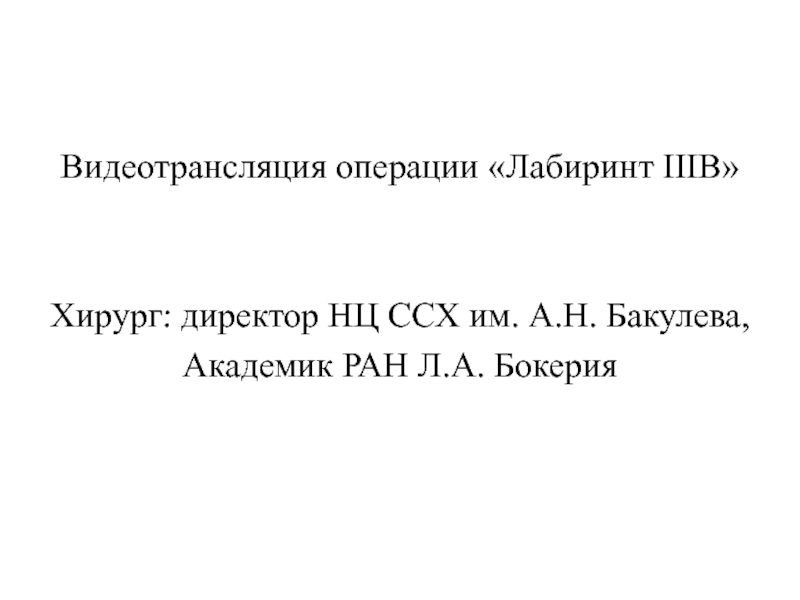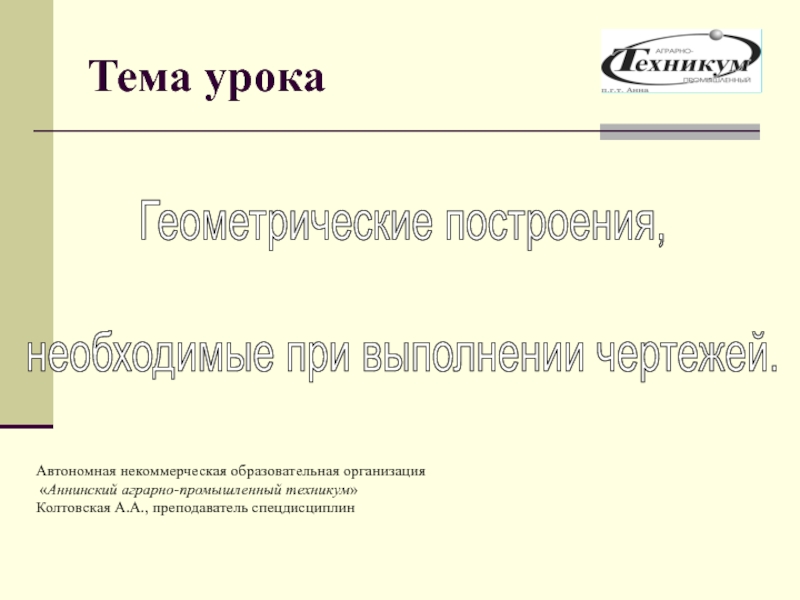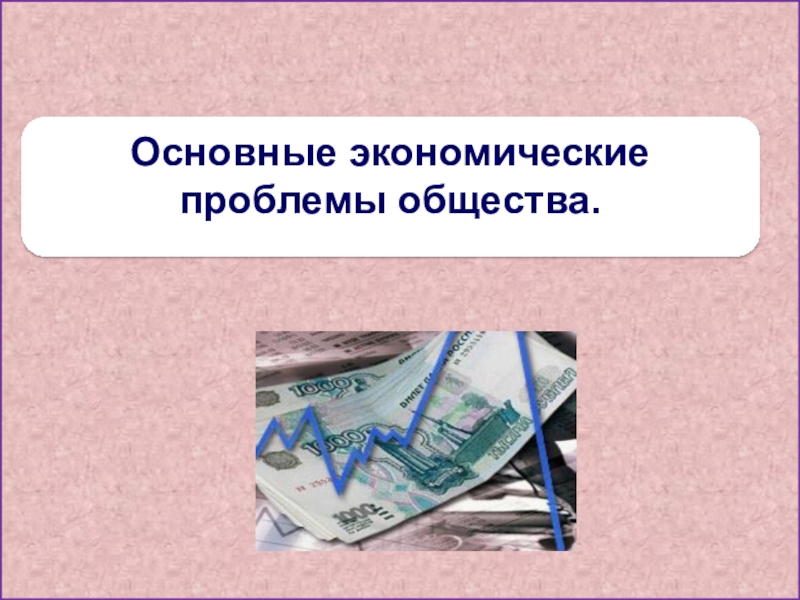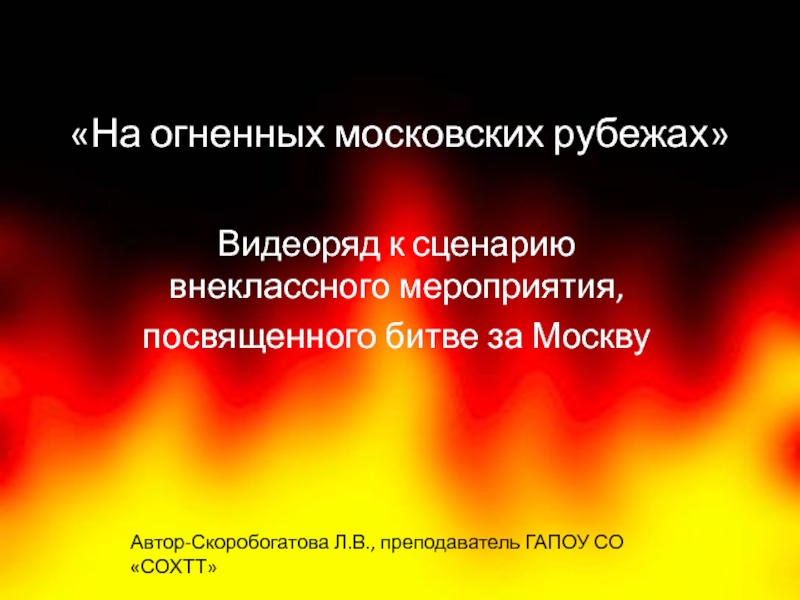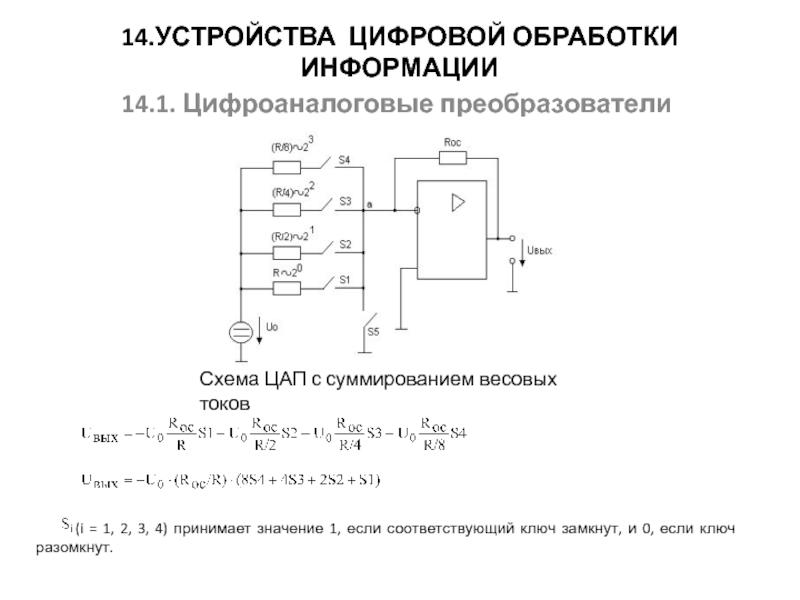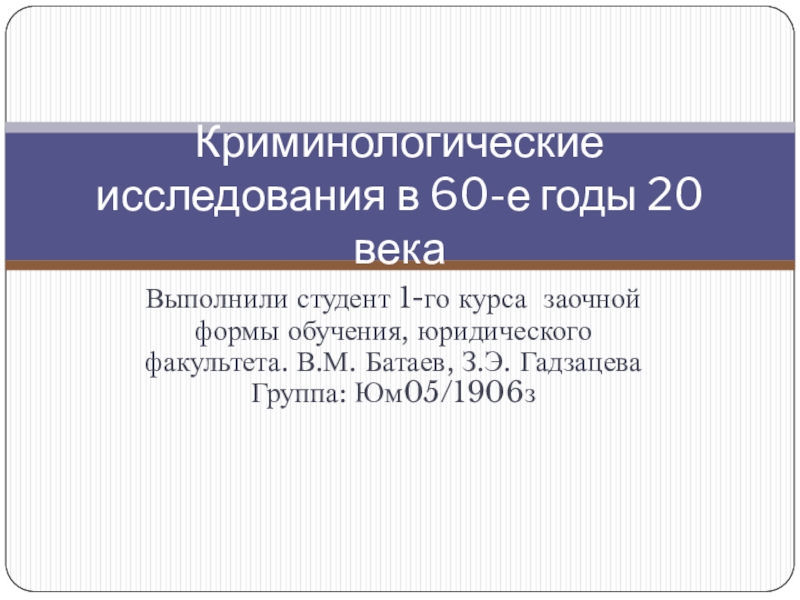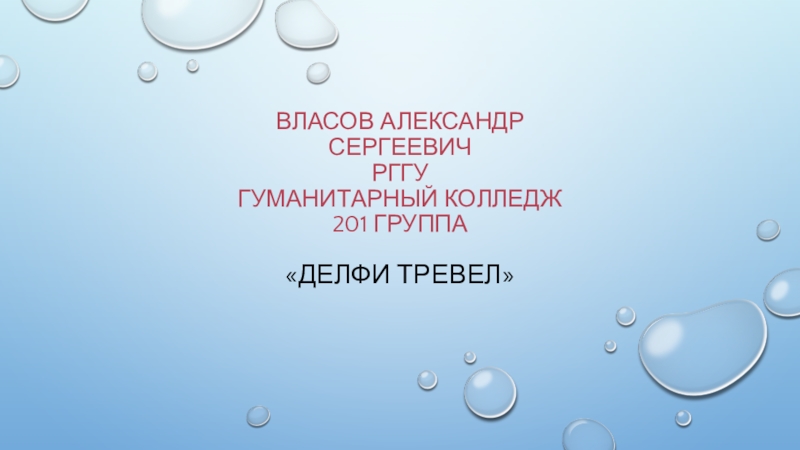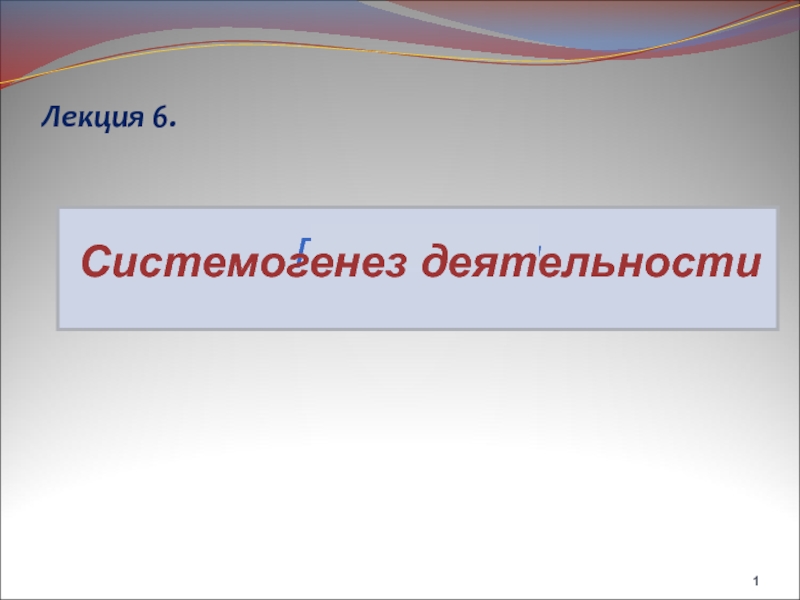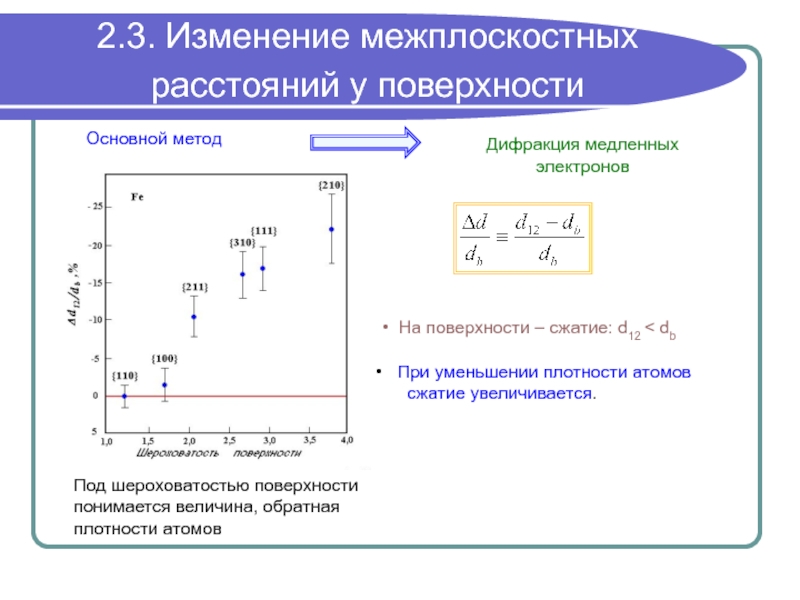Слайд 1HAVAL H5 Cruise Control System
Department:Technical Service Dept.
Date:Dec. 1, 2010
Слайд 2CCS Overview
CCS Components and Working Principle
Cruise Control Strategies and Setting
Contents
1
Слайд 3CCS Overview
1. CCS Overview
When the vehicle
has been traveling for a long time on the highway, the
CRUISE CONTROL SYSTEM (CCS), after being activated by the driver, will automatically adjust the output power and torque according to the rolling resistance. In this way, the driver may drive the vehicle at a fixed setting speed without controlling the accelerator pedal.
The application of CCS can relieve the driver’s efforts, alleviate unnecessary speed change, enhance the comfortableness and safety in driving , save fuel and cut down emission.
Слайд 42. The Development of CCS
The first stage (from the 1960s to
the middle of 1970s):in early stage, there are mainly two
kinds of CCS: mechanical CCS and air-actuated mechanical CCS.
For example, since 1965, Toyota Motor Corporation has installed mechanical CCS on its vehicles.
Слайд 5The second stage (from the 1970s to the middle of
1980s):there came out the digital signal-based CCS.
In order to realize
cruise speed regulation, the micro processor completes all data processing, produces drive signal output of stepping motor and changes the valve opening according to the instructed speed, actual speed, other input signal and preset procedures.
Слайд 6The third stage (from 1990s): there appeared the intelligence-centered automatic
CCS and the fixed distance-controlled self-adaptive CCS abroad.
The system detects
the vehicle distance to the vehicle ahead by the FMCW radar, figures out relative speed and distance and provides these data to electronic control unit by the processing unit and regulates the speed through throttle, which is controlled by actuators.
Слайд 73. Functions of CCS
(1) Maintaining the set speed: the uniform running is
realized through the driver’s set system, which takes the set
speed as the targeted speed.
(2) Fine adjusting the target speed: fine adjust the set speed to achieve the expected speed.
(3) Resuming the speed: after relieving cruise control initiatively or passively and before disconnecting master switch, resume the speed set previously by pressing “Reset”.
Слайд 8(4) Relieving cruise control in abnormal speed change:
In cruise, the CCS
will cancel the cruise control mode automatically when the speed
changes abruptly in 1 second (for instance, the speed error is over 15km/h).
(5) Manipulating the process of cruise control relief : the driver disengages cruise control by pressing brake pedal and clutch pedal in cruise.
Слайд 94. Advantages of CCS
(1) Maintaining a constant speed: whether the vehicle travels
uphill, downhill or on even and straight road, the CCS
guarantees it to travel at uniform speed as long as the engine’s power is in agreeable range.
(2) Enhancing the comfortableness in driving: the application of CCS relieves driver’s fatigue.
(3) Saving the fuel: when the vehicle is traveling at constant speed, the system can realize the optimum match of fuel consumption and output power of the engine.
Слайд 10Ⅱ The Components and Working Principle of HAVAL H5 CCS
1. The
components of CCS
The CCS is mainly composed of cruise control
switch, brake switch, clutch switch, speed sensor, engine ECU, actuators and indicator lamp.
As the HAVAL H5 CCS is installed with an automatic transmission, the driver hasn’t to use clutch switch. As for the manual transmission model, if the driver presses the clutch in cruise, the system will cancel the cruise control mode automatically.
Слайд 11Schematic diagram for the components of HAVAL H5 CCS
Слайд 12Cruise switch
When the cruise switch is at different positions, the
current earths and provides various voltage signals to engine ECU
after flowing through resistors with different resistance values. Then the engine ECU estimates the driver’s purposes based on these voltage signals received.
The cruise switch is installed on steering wheel.
Слайд 13Speed sensor
The K5N2-type vehicle is subject to overall CAN communication.
The engine ECU receives speed signal through CAN and implements
closed loop control to cruise speed.
Speed sensor
Слайд 142. Working principle of CCS
The engine ECU receives signals out of
the cruise switch. If the difference between the tested actual
speed and the set speed is beyond the allowable range, the engine ECU, after comparing those two signals, will produce and send a control signal to the fuel injector, so as to regulate the output power and torque. Then a constant speed is maintained.
Recently, the cruise control function is only available for luxurious, super-luxurious, elite and scuttle-configured HAVAL H5, which has 4D20 engine with corresponding 5AT automatic transmission.
Cruise switch signal
Speed sensor signal
Actuator (Fuel injector)
Brake switch signal
Cruise indicator
Engine ECU
Слайд 153. Introduction to the functions of cruise switch
Cruise master switch: CRUISE
a. When
you press the master switch, the indicator on the instrumentation
lights on, which represents that the cruise is on standby. Besides being on standby, in cruise the indicator lamp is also on.
b. Press the “CRUISE” button in cruise to close the cruise function.
Слайд 16Combination button for cruise setting and deceleration: SET/-
Cruise setting
Accelerate the
vehicle to the desired speed. Then, press the “SET/-” button
on the steering wheel and release the accelerator simultaneously.
Слайд 17Combination button for cruise setting and deceleration: SET/- Reducing cruise
speed
When the user presses and holds the “SET/-” , the
cruise speed will reduce constantly. Release the button at your desired cruise speed.
The cruise speed will lower 3km/h for each pulse of “SET/-” button.
Слайд 18RES/+: Combination button for cruise resumption and acceleration
Resetting speed
If
the cruise control is cancelled in cruise (pressing brake pedal
for example) but the system is still on standby, click the button to resume the speed before the cancellation of function as long as the corresponding conditions are satisfied.
Слайд 19RES/+: Combination button for cruise resumption and acceleration
Cruise acceleration
When
you press and hold the “RES/+”button in cruise, the cruise
speed will increase continuously.
The speed will increase 3km/h for each time for each pulse of “RES/+” button.
Слайд 20CANCEL: Cancellation button for cruise control
If you click the
“CANCEL” button in cruise, the cruise control will be cancelled.
Слайд 21Cruise setting
Accelerate the vehicle to the desired speed (a speed
over 60km/h is compulsory.) and click master switch “CRUISE” .
Then, the indicator lamp on instrumentation lights up and will keep on in cruise (please refer the attached diagram for details) .
Then, click the “SET/-” button on steering wheel and release accelerator pedal simultaneously. The vehicle will run at your set speed, which will be screened on the LCD of instrumentation as number.
Cruise control strategies and setting
Слайд 22After you press the master switch “CRUISE”, the indicator lamp
on instrumentation will light up; the lamp will be always
on both in ready status and in cruise.
Слайд 23Increasing the cruise speed
The speed in cruise control can be
accelerated by any one of the following operations:
When you press
and hold the “RES/+” (for more than 0.4s), the cruise speed is increasing continuously; and then relieve the button at your desired speed. That is to say the vehicle can cruise at this speed.
The speed will increase 3km/h for each pulse of the “RES/+”(less than 0.4s).
Слайд 24Increasing cruise speed provisionally
If you want to increase speed provisionally
in cruise, press the accelerator pedal to a certain value.
The
speed increase has no influence on the operation of CCS and the set speed. After you release the accelerator pedal, the set cruise speed will resume.
Слайд 25Reducing the cruise speed
The speed in cruise can be lowered
in any one of the following cases:
When you press and
hold the “SET/-” button (for more than 0.4s but less than 100s), the speed is increasing continuously. Release the button at your desired speed.
The cruise speed will lower 3km/h for each pulse of the “SET/-”(less than 0.4s).
Caution: the cruise control will be cancelled automatically at the speed lower than 60km/h.
Слайд 26Cruise cancellation
The cruise control is disengaged in any one of
the following cases:
Pressing the brake pedal;
Pressing the “CANCLE” button on
steering wheel;
The speed is lower than 60km/h or quicker than 170km/h;
Cancellation resulted from malfunction;
The gear lever in transmission is operated to the Gear N;
Others.
Caution: canceling cruise doesn’t mean closing cruise function.
Слайд 27Resume cruise after cancellation
If the cruise control is cancelled
in cruise but the system is still on standby, click
the “RES/+” button to resume the speed before the cancellation of function as long as the following conditions are satisfied:
The speed is over 60km/h;
The master switch “CRUISE” is never closed.
Слайд 28Closing cruise
The cruise can be closed in any one of
the following cases:
Press the “CRUISE” button and the indicator lamp
on the instrumentation will go out;
Turn off the ignition switch.
If you want to resume the cruise mode after it was closed, reset the cruise according to “Cruise Setting”.
.
Слайд 294. Utilization Precautious
The cruise control can maintain a speed not
lower than 60km/h without the accelerator pedal being pressed. It
is advisable to engage the cruise control on straight and smooth motorway.
It is not advisable to engage the cruise control in urban area, on zigzag, wet and sliding roads or in rainy and snowy days or any other atrocious weather. otherwise heavy traffic accidents may happen.
Review
CCS Overview
CCS Components
and Working Principle
Cruise Control Strategies and Setting
